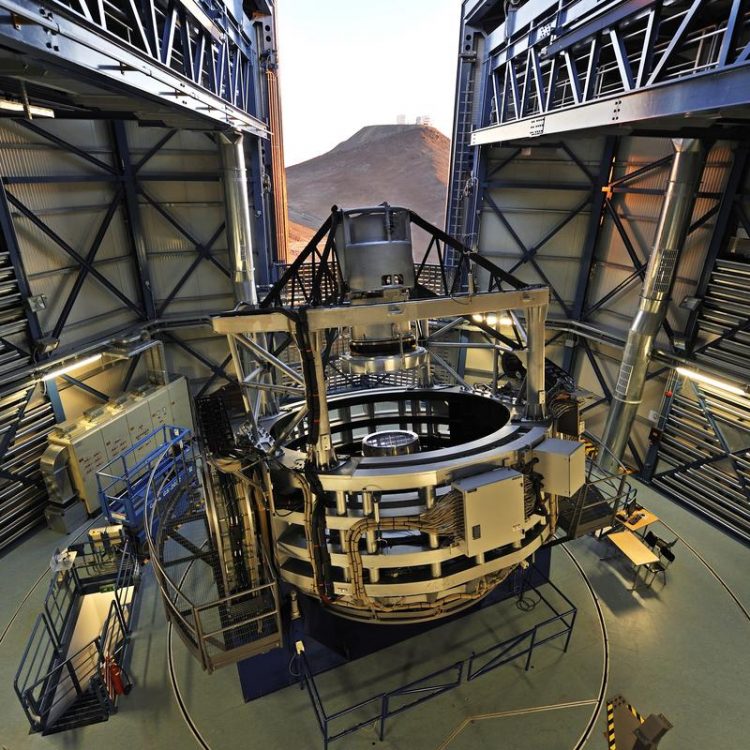Milky Way and beyond: Next Generation Survey Telescope

The VISTA telescope at the ESO Paranal Observatory in Chile. Credit: G. Hüdepohl (atacamaphoto.com) / ESO
In a special issue of the ESO Messenger, several articles give a project overview and provide astronomers with detailed information about the first Call for Proposals, the Scientific Operations and the Survey Strategy Plan.
“Also, each of the planned surveys are described, thus preparing the ESO community for the Call for Letters of Intent to use the facility, which will be released in the second half of 2019”, says Roelof de Jong, Principal Investigator of 4MOST.
“This will be a singular opportunity for the astronomical community to apply to use the facility during its first five years of observation.”
4MOST is a new wide-field spectro¬scopic survey facility under develop¬ment for the four-metre-class Visible and Infrared Survey Telescope for Astronomy (VISTA) at Paranal in Chile. It is on one of the best observatory sites in the world and provides access to unique objects in the southern hemisphere, most notably the Galactic Centre and the Magellanic Clouds. The 4MOST design allows tens of millions of spectra to be obtained via five-year surveys, even for targets distributed over a significant fraction of the sky.
The instrument is under construction at a number of consortium institutes, coordinated by the Leibniz Institute for Astro¬physics Potsdam (AIP), Germany. On the operations side, the proposal selection process starts while the manufacturing will continue into 2021. Once the subsystems are finished at the different insti¬tutes, they will all be transported to Potsdam and extensively tested as a full system. In 2022, they will be shipped to Chile and installed on the VISTA telescope.
The 4MOST operations scheme differs from other ESO instrument operations in that it allows many different science cases to be scheduled simultaneously during one observation.
The science programme itself is organised into surveys centred on stellar objects to perform Galactic archaeology of different components of the Milky Way and the Magellanic Clouds, on extragalactic objects aiming to characterise cosmological parameters, the nature of dark energy and dark matter, and the formation history of galaxies and black holes.
All surveys on 4MOST will be public surveys, which means that the raw data and higher-level survey products will be published in the ESO archive.
The 4MOST consortium consists of 15 institutes in Germany, the UK, France, Sweden, Switzerland, Australia, and the Netherlands, under leadership of the Leibniz Institute for Astrophysics Potsdam (AIP). More than 330 scientists and engineers are working on 4MOST and contributed to the now published articles.
4MOST consortium members:
Leibniz-Institut für Astrophysik Potsdam (AIP)
Australian Astronomical Optics, Macquarie University (AAO)
Centre de Recherche Astrophysique de Lyon (CRAL)
European Southern Observatory (ESO)
Institute of Astronomy, Cambridge (IoA)
Max-Planck-Institut für Astronomie, München (MPIA)
Max-Planck-Institut für extraterrestrische Physik, München (MPE)
Zentrum für Astronomie der Universität Heidelberg (ZAH)
NOVA/ASTRON, Dwingeloo
Rijksuniversiteit Groningen (RuG)
Lunds Universitet (LU)
Uppsala Universitet (UU)
Universität Hamburg (UHH)
University of Western Australia (UWA)
École polytechnique fédérale de Lausanne (EPFL)
Dr. Roelof de Jong, 0331-7499-648, rdejong@aip.de
Media Contact
All latest news from the category: Physics and Astronomy
This area deals with the fundamental laws and building blocks of nature and how they interact, the properties and the behavior of matter, and research into space and time and their structures.
innovations-report provides in-depth reports and articles on subjects such as astrophysics, laser technologies, nuclear, quantum, particle and solid-state physics, nanotechnologies, planetary research and findings (Mars, Venus) and developments related to the Hubble Telescope.
Newest articles

Silicon Carbide Innovation Alliance to drive industrial-scale semiconductor work
Known for its ability to withstand extreme environments and high voltages, silicon carbide (SiC) is a semiconducting material made up of silicon and carbon atoms arranged into crystals that is…

New SPECT/CT technique shows impressive biomarker identification
…offers increased access for prostate cancer patients. A novel SPECT/CT acquisition method can accurately detect radiopharmaceutical biodistribution in a convenient manner for prostate cancer patients, opening the door for more…

How 3D printers can give robots a soft touch
Soft skin coverings and touch sensors have emerged as a promising feature for robots that are both safer and more intuitive for human interaction, but they are expensive and difficult…





















